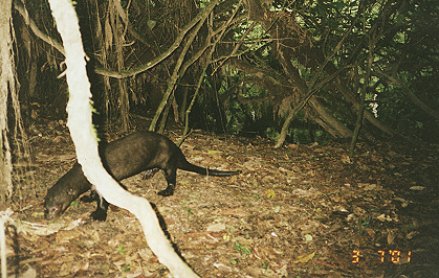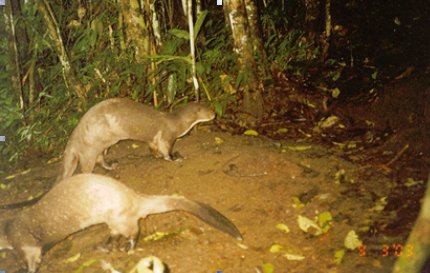 |
Last Update:
Thursday November 22, 2018
|
| [Home] |
|
Volume 20 Issue 2 Pages 58 - 90 (October 2003) Citation: Utreras, V., Pinos, L. (2003) Camera Trap Use For Studying Giant Otters (Pteronura brasiliensis) In The Yasuní Biosphere Reserve, Ecuadorian Amazon. IUCN Otter Spec. Group Bull. 20(2): 69 - 71 Camera Trap Use For Studying Giant Otters (Pteronura brasiliensis) In The Yasuní Biosphere Reserve, Ecuadorian Amazon Víctor Utreras1, Luis Pinos2 1 Wildlife Conservation
Society - Ecuador Program. P.O. Box 17-21-168, Quito - Ecuador e-mail: vmub@wcsecuador.org Since January 2003, during field surveys of giant otters (Pteronura brasiliensis) carried out in the Yasuní Biosphere Reserve (north-eastern Ecuadorian Amazon), we have been testing the use of camera traps as a supplementary technique for studying this species. Camera traps are used for population monitoring of several medium to large size wildlife species. This technique can also provide information about home range size, habitat use, and behavioural activities such as daily and seasonal movements and activity periods. In addition, it is possible to identify many individuals through distinctive features using camera traps activated by the individuals themselves. We have tested the CamTrakker equipment, which combines a fully automatic 35 mm camera with a passive infrared heat-in-motion detector. When something that moves and gives off heat passes by, a silent electronic switch engages the camera that takes the photograph. Time selector switches allow the field researcher to select one of six time-delays and three modes of operation. These features allow day and night operation and reduce the chance of too many photos of the same individual. During fieldwork, four camera traps were located near dens and latrines (marking areas) of three giant otter groups in the study area. We recommend setting the time selector switch to a range of 20-90 seconds, as visit times are usually very short, and to use ISO 200 36 frame colour print film. When installing the camera in the field, we also advise setting it up 50 cm above the ground, taking into account potential changes in water level that might damage the equipment. A preliminary analysis of the utilisation of this technique with
giant otters shows that camera traps provide useful information about
movement patterns in the activity area of each group, frequency of
visits to specific locations, such as campsites, daily activity periods
in dens and latrines, identification and monitoring of specific
individuals based on distinctive features such as spot patterns,
presence of offspring, sex determination (especially adult females), and
pregnancy (Figures 1, 2, 3).
Acknowledgements - The research on giant otters in the Yasuní Biosphere Reserve is part of the Living Landscape Program of the Wildlife Conservation Society - Ecuador Program, with the support of USAID. |
| [Copyright © 2006 - 2050 IUCN/SSC OSG] | [Home] | [Contact Us] |


